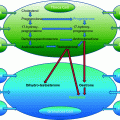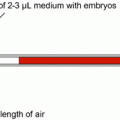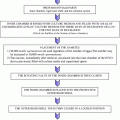© Springer International Publishing AG 2017
Ri-Cheng Chian, Geeta Nargund and Jack Y. J. Huang (eds.)Development of In Vitro Maturation for Human Oocytes10.1007/978-3-319-53454-1_1010. Risk Factors and Preventive Measures of Ovarian Hyperstimulation Syndrome
(1)
Department of Obstetrics and Gynecology, Seoul National University Bundang Hospital, 82, Gumi-ro 173beon-gil, Bundang-gu, Seongnam, Gyeonggi, 463-707, Korea
Keywords
Polycystic ovary syndromeOvarian stimulationHuman chorionic gonadotropinGnRH agonistGnRH antagonistMetforminCoastingCryopreservationHydroxyethyl starchVascular endothelial growth factorIntroduction
Ovarian hyperstimulation syndrome (OHSS) is an iatrogenic complication of exogenous ovarian stimulation used in assisted conception technique. The pathophysiology of OHSS is characterized by increased capillary permeability leading to vascular fluid leakage, third space fluid accumulation, and intravascular dehydration [1]. OHSS is classified according to the clinical features and laboratory findings as mild, moderate, or severe. In severe cases, the process can result in multiple organ dysfunctions, including a tendency for thrombosis, renal and hepatic dysfunction, and pulmonary edema. Such patients can develop critical disease, which may involve cerebral infarction, adult respiratory distress syndrome, hepatorenal failure, and even death [2].
OHSS develops as a result of mediators released from hyperstimulated ovaries. The nature of these vasoactive substances remains unclear, but vascular endothelial growth factor (VEGF) and a variety of pro-inflammatory cytokines may be involved [3]. The background changes that lead to OHSS occur during the phase of ovarian stimulation with follicle-stimulating hormone (FSH), but full manifestation of the clinical syndrome requires exposure to luteinizing hormone (LH) or human chorionic gonadotropin (hCG).
The onset of OHSS reflects the effect of hCG exposure at different stages of the condition. ‘Early’ OHSS occurs within 9 days of hCG triggering and reflects the effect of exogenous hCG, resulting in an excessive ovarian response. ‘Late’ OHSS occurs 10 or more days after the ovulatory dose of hCG and reflects the effect of endogenous hCG from an early pregnancy. Although early and late OHSS have distinct clinical presentations [4], they appear to be similar in terms of disease severity [5].
It is difficult to estimate accurately the incidence of OHSS, owing to the use of a variety of classification schemes, and the varying incidence between treatments and patient groups. Mild OHSS may be common in stimulated in vitro fertilization (IVF) cycles. Moderate-to-severe OHSS has been reported to occur in 2–8% of IVF cycles [6, 7]. In a report from Finland, the rate of hospitalization for OHSS following ovulation induction was 0.04% per cycle, whereas 0.9% was observed following IVF [8].
Risk Factors for OHSS
Pretreatment Patient Characteristics
Young patients are at a greater risk of developing OHSS [9, 10]; this may be related to the greater probability of pregnancy in younger women, and a greater sensitivity of their ovaries to exogenous gonadotropins. Navot et al. [6] observed a lower mean body weight among women with OHSS, but this was not confirmed in a larger study [9]. A previous history of OHSS is a risk factor for developing OHSS in subsequent ovarian stimulation cycles [9].
OHSS is more frequent in women with polycystic ovaries (PCO) or polycystic ovary syndrome (PCOS) [6, 9, 11]. Patients with PCO were twice as likely to develop OHSS, compared with patients without PCO, despite receiving lower dose of gonadotropins [11]. The presence of isolated characteristics of PCOS, such as hyperandrogenism and anovulation, may also be risk factors for OHSS, even if the patient does not fulfill all of the criteria for PCOS [9]. Patients with PCOS display a higher sensitivity to gonadotropins, due to the larger size of the FSH-sensitive cohort of small antral follicles. If the gonadotropin dose oversteps the threshold FSH level needed for ovarian stimulation, multifollicular development ensues.
High pretreatment serum level of anti-Müllerian hormone (AMH) and a high pretreatment antral follicle count (AFC) are known to be associated with an excessive response to ovarian stimulation [12]. Serum AMH level is usually elevated in women with PCOS and a higher level of serum AMH is associated with a greater risk of OHSS [13–15]. A cutoff value of AMH >3.5 ng/ml and AFC >10 is shown to be highly and equally predictive of ovarian hyperstimulation [13].
Ovarian Response Parameters
A high serum estradiol concentration during ovarian hyperstimulation, a large number of follicles, and a large number of oocytes retrieved have all been reported to be associated with an increased risk of OHSS [16, 17]. However, the value of these parameters in predicting the risk of OHSS is poor, and the cutoff values are often arbitrary. A peak serum estradiol level of 3000–6000 pg/ml has been suggested for predicting high risk for OHSS [18]. Further, no agreement is reached regarding the size and number of the follicles. Unlike late OHSS, early OHSS can be predicted to some extent by the serum estradiol concentration even though its predictive value is modest [4].
Preventative Measures
Starting Dose and the Type of FSH
Factors that may increase the risk of excessive ovarian response, such as PCO/PCOS, previous history of OHSS and young age, should be taken into account before choosing the starting dose of FSH. In those situations, a lower starting dose is usually recommended. The starting dose of FSH can be tailored according to the woman’s age or serum level of AMH [15].
No significant difference in the occurrence of OHSS was noted between recombinant FSH and urinary FSH, either in patients with clomiphene-resistant PCOS [19] or in general IVF candidates [20]. Also, two meta-analyses showed similar incidence of OHSS between recombinant FSH and human menopausal gonadotropin (hMG) [21, 22]. A recent meta-analysis demonstrated that the incidence of OHSS was similar between recombinant FSH and highly purified hMG [23].
GnRH Agonist Versus Antagonist
Since the introduction of therapeutic gonadotropin-releasing hormone (GnRH) agonists in 1986, the incidence of severe OHSS has increased sixfold, compared with IVF cycles stimulated by clomiphene/hMG only [7]. A Cochrane review found a significantly lower incidence of OHSS in GnRH antagonist cycles compared with GnRH agonist cycles (relative risk, RR, 0.61) [24]. A meta-analysis by Ludwig et al. [25] reported no significant reduction in the risk of OHSS with the antagonist protocol, compared with the agonist protocol. However, a subgroup analysis indicated that there was a significant reduction in the incidence of OHSS in cycles using the GnRH antagonist cetrorelix (odds ratio OR, 0.23), but no such reduction in cycles using another GnRH antagonist ganirelix (OR, 1.13). In two recent meta-analyses that included women with PCOS, the GnRH antagonist protocol showed either a statistically significant (OR, 0.36) or nonsignificant (OR, 0.64) reduction in severe OHSS, compared with a long agonist protocol [26, 27]. Thus, a GnRH antagonist protocol may be preferentially considered in patients at high risk for OHSS.
Dose of hCG for Triggering
Given the positive association between the dose of hCG and the risk of OHSS [28], the lowest effective dose of hCG should be used to minimize the risk of OHSS. Urinary hCG of less than 5000 IU for triggering would appear to be reasonable in high-risk patients.
Urinary hCG is used to mimic the endogenous LH surge due to its structural similarity with human LH. Nowadays, recombinant LH may be used for the same purpose. The luteotropic effect of hCG is more prolonged than that of endogenous LH; hence, it has been suggested that triggering ovulation using recombinant LH, instead of hCG, may reduce the risk of OHSS. However, a meta-analysis of two trials comparing the incidence of OHSS between cycles using recombinant LH and cycles using urinary hCG for triggering did not show any difference [29]. Moreover, the incidence of severe OHSS was quite high in both groups (recombinant LH, 10.3%; urinary hCG, 12.4%). Further trials are needed to assess the efficacy of use of recombinant LH in the prevention of OHSS.
Choice of Luteal Support
Luteal support with hCG should be avoided in patients with a high risk of OHSS, because hCG has a critical role in precipitating and worsening established OHSS. Progesterone is as effective as hCG for luteal support and is associated with a lower risk of OHSS [31].
Metformin Co-treatment During Ovarian Stimulation
In an RCT in 2006, Tang et al. [32] administered placebo or metformin 850 mg, twice daily, from the first day of down-regulation to oocyte pickup (OPU) day, to women with PCOS undergoing IVF; the incidence of severe OHSS was significantly reduced in the metformin group (OR, 0.15). A systematic review showed a significant reduction in the incidence of OHSS with the use of metformin (OR, 0.21) in women with PCOS undergoing IVF [33]. A recent meta-analysis demonstrated significant reduction in the risk of OHSS (OR, 0.27) and the risk of miscarriage (OR, 0.50) after metformin administration [34]. Therefore, current evidence supports the concept that metformin co-treatment during ovarian stimulation may reduce the risk of OHSS in women with PCOS.
Coasting
Coasting refers to method where exogenous gonadotropin administration and hCG trigger are withheld (while maintains pituitary suppression) until serum level of estradiol declines to a ‘safer’ predefined level. After daily measurement of serum estradiol and follicular tracking, hCG trigger can be done, followed by OPU and embryo transfer (ET). The rationale for coasting is that larger follicles have a lower dependence on FSH than smaller follicles and are capable of continuing their growth and maturation in the face of depleted gonadotropin stimulation, while small and intermediate follicles undergo atresia. Declining concentrations of vasoactive mediators from the ovary, such as VEGF, may contribute to the efficacy of coasting [35].
There are several retrospective studies examining the efficacy of coasting in the prevention of OHSS. In a qualitative systematic review of 12 studies including 493 patients, fertilization and pregnancy rates after coasting were acceptable, and 2.5% of the patients required hospitalization for OHSS [36]. Although coasting does not abolish the risk of OHSS, it appears to lower the incidence of OHSS [37]. A survey of 573 members of the European Society of Human Reproduction and Embryology (ESHRE) found that coasting is the most common strategy used to prevent OHSS [38].
The typical serum estradiol level used to initiate coasting is >3000 pg/ml [39] and the criterion for cessation (and hCG triggering) is below 3000 pg/ml or 3500 pg/ml [37, 40]. An abrupt drop in serum estradiol level, or a drop less than 1000 pg/ml, may be associated with a low fertilization rate and poor outcome [37]. The duration of coasting depends on the initial estradiol level, with higher estradiol levels requiring more prolonged coasting, before it drops to the designated ‘safer’ level. Coasting for more than 3–4 days may be associated with poorer cycle outcomes [37].
In a retrospective analysis of 1223 coasted cycles, Mansour et al. [40] found a lower clinical pregnancy rate following intracytoplasmic sperm injection (ICSI) cycles with coasting for >3 days, compared with cycles with ≤3 days of coasting (36% vs. 52%). Garcia-Velasco et al. [37] found a lower implantation rate in patients who had been coasted for >4 days (15.5% in >4 days group vs. 28.5% in ≤4 days group). Based on these data, cycle cancellation may be the preferred alternative if hCG triggering does not look feasible on the 4th day of coasting.
Follicle Aspiration Prior to hCG Administration
In an attempt to reduce the risk of OHSS by reducing the total pool of luteinized granulosa cells in the ovary, aspiration of some follicles prior to hCG triggering has been suggested. This approach produced beneficial results in 14 patients returning for further IVF cycles after cycles complicated by OHSS [41]. In contrast, Schroder et al. reported that 80% of the subjects developed severe OHSS following this procedure [42]. No benefit was seen for aspiration of all follicles from one ovary 6–8 h prior to hCG triggering in 16 women at high risk of OHSS compared with 15 matched control subjects in whom aspiration was not performed [43]. In patients at high risk of OHSS, 3 and 4 cases of OHSS out of 15 patients undergoing coasting and 15 patients undergoing early follicle aspiration were revealed, respectively [44]. Thus, the evidence regarding timed follicular aspiration prior to hCG triggering remains uncertain.
Cycle Cancellation
OHSS develops only in cycles with an exposure to endogenous or exogenous hCG. Consequently, the most effective method of prevention is to withhold hCG, and in turn, cancel the treatment cycle. Despite the fact that the emotional and financial costs of the cycle cancellation would be significant, cycle cancellation can be an alternative option when the ovarian response is excessive, and embryo cryopreservation is not a viable option.
GnRH Agonist Triggering in GnRH Antagonist Cycles
In GnRH antagonist cycles, a GnRH agonist can be used to induce an endogenous LH surge, leading to final follicular maturation. Endogenous LH has a shorter half-life than hCG; thus, it is less likely to cause OHSS compared with hCG. From a systematic review of 3 RCTs that compared the use of a GnRH agonist with hCG triggering in GnRH antagonist cycles in normal responders, GnRH agonist triggering was associated with a significant reduction of the clinical pregnancy (OR, 0.21) without a prevention of OHSS [45]. This discouraging pregnancy result might be associated with a frequent occurrence of luteal phase deficiency in GnRH agonist-triggered cycles. Therefore, Kol [46], Kol and Solt [47] mentioned adequate luteal support to compensate luteolysis in GnRH agonist-triggered cycles for good clinical outcome. A recent meta-analysis indicated that ‘GnRH agonist triggering combined with aggressive or modified luteal phase support’ can provide a safe and OHSS-free clinical environment, with an acceptable rate of clinical pregnancy [48]. Currently, this strategy may be helpful in patients at high risk for OHSS, but not in normal responders. Modified luteal phase support includes daily intramuscular progesterone and oral estrogen [49] or low-dose hCG only (250 or 500 IU at OPU + 1, OPU + 4, and OPU + 7) [50]. GnRH agonist triggering in GnRH antagonist cycles may also be a useful method in oocyte donors, and cancer patients who pursue fertility preservation.
Intravenous Albumin Versus Hydroxyethyl Starch
Administration of intravenous (IV) albumin around the time of OPU has been proposed as a measure to prevent OHSS [51]. A number of RCTs that included small numbers of patients at high risk of OHSS showed a reduced incidence of severe OHSS in the group receiving IV albumin. In 2002, a Cochrane meta-analysis of 5 RCTs showed a significant reduction in the incidence of severe OHSS in women receiving IV albumin (OR, 0.28) [52].
However, a systematic review by Delvigne and Rozenberg [7], which included data from prospective randomized studies and a single retrospective study, reported no significant difference in the incidence of OHSS between patients receiving IV albumin and controls. A subsequent single-center RCT revealed that the incidence of moderate-to-severe or severe OHSS did not differ between albumin treatment and no treatment groups (40 g IV albumin group, 7.1% moderate to severe, 5% severe; no treatment group, 6.7% moderate to severe, 4.7% severe) [53]. In addition, a recent meta-analysis of data including 1613 women at high risk of OHSS demonstrated that the incidence of severe OHSS was 6.0% in the IV albumin group, and 7.9% in saline or no treatment groups, which was not statistically different [54]. Moreover, treatment with IV albumin was associated with a significant reduction in pregnancy rates (RR, 0.85). Thus, the currently available data do not support administration of IV albumin around the time of OPU in the prevention of OHSS.
Hydroxyethyl starch (HES) is a synthetic high molecular weight compound, used as a plasma volume expander, as an alternative to albumin. A group of investigators reported the use of 1000 ml of 6% HES at the time of OPU and 500 ml at the time of ET in 100 high-risk women [55]. Even though the incidence of moderate OHSS was reduced, the incidence of severe OHSS between the treatment and historical control group did not differ significantly.
A subsequent RCT assessed the effectiveness of 1000 ml of 6% HES, administered at the time of ET, in women at high risk of OHSS [56]. The incidence of moderate-to-severe OHSS was significantly lower in the treatment group than that in the placebo group (2% vs. 13%). Gokmen et al. [57] found both albumin and HES to be superior to placebo in preventing OHSS in women with a serum estradiol >3000 pg/ml, and >20 follicles on the day of hCG triggering. Although, in this study, there was no significant difference in the incidence of OHSS between the albumin and HES groups, the authors showed a preference for HES on the grounds of cost and safety. A recent Cochrane review demonstrated that HES significantly decreases the incidence of severe OHSS (OR, 0.12), without affecting the pregnancy rate [58]. This finding also supports the use of HES over albumin in the prevention of OHSS.
Stay updated, free articles. Join our Telegram channel

Full access? Get Clinical Tree







